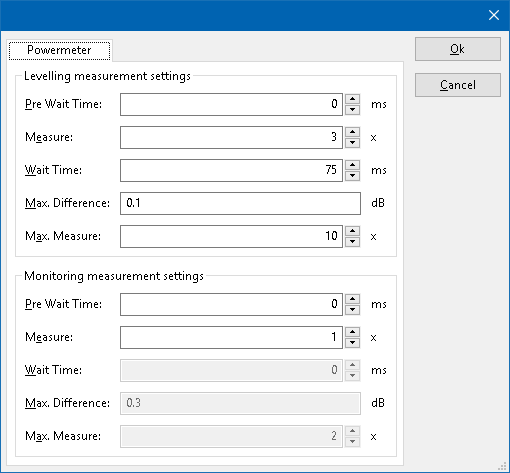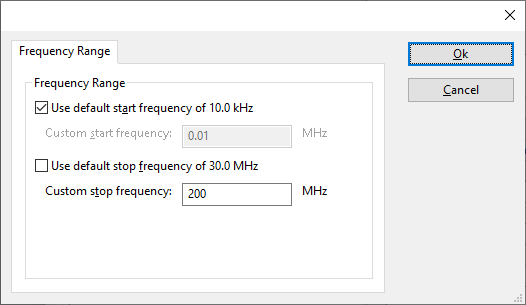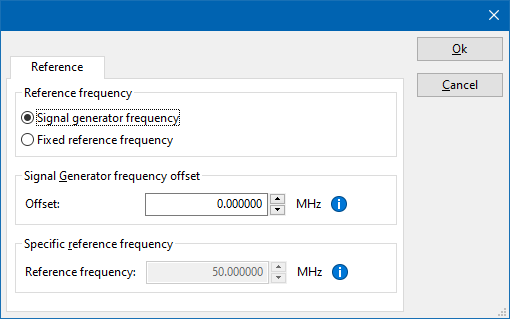Difference between revisions of "Tektronix SignalVu-PC"
DevicesBot (talk | contribs) (Updated DeviceDriverInfo template) |
|||
| Line 4: | Line 4: | ||
|DeviceDriverName=TEKTRONIX_SIGNALVU_PM | |DeviceDriverName=TEKTRONIX_SIGNALVU_PM | ||
|DeviceType=SignalVu-PC | |DeviceType=SignalVu-PC | ||
| + | |HideAutoData=1 | ||
|SupportedDeviceTypes=520 | |SupportedDeviceTypes=520 | ||
| − | |||
}} | }} | ||
Revision as of 02:05, 30 December 2020
The Tektronix SignalVu-PC device driver is a Power Meter, Spectrum Analyser which is supported by RadiMation®.
Configuration
The following tabs are available in the advanced configuration of the Tektronix SignalVu-PC:
| Wait time before starting the measurement-loop. Can be used to wait for a signal generator, and or amplifier to stabilize. |
| The minimum amount of measurements in the measure loop. Continues to loop even if power level is stable. |
| The wait time between each measurement is taken, during the measurement-loop. |
| If the measured power between each measurement in the measurement-loop, is less than this value. The measured power is stable. The measurement-loop will then stop. |
| The maximum amount of measure times, for the measurement-loop |
According to these settings, RadiMation® will perform a minimum of 3 power measurements with a wait time between the measurements of 75ms. If all those 3 measurements are within 0.1 dB, the power measurement is assumed to be stable, and RadiMation® will continue to average of the last 3 measurements. If the difference between the measurements is larger than the specified 0.1 dB, an additional power measurement will be performed, and the last 3 samples will be compared to the 0.1 dB difference again. At most 10 measurements will be performed if the difference between the 3 samples will not be within the specified 0.1 dB.
Both for the leveling, and the monitoring these settings can be set individually. The leveling is used, whenever RadiMation® is measuring the power, to regulate the signal generator. If the powermeter is only used as input, without regulating on it, then the monitoring settings are used.
More detailed information on how to achieve a fast and stable power measurement is available in Application Note 106: Powermeter parameter configuration.
The frequency range of the Tektronix SignalVu-PC as provided by the manufacturer is shown and selected as default. It is possible to overrule these frequencies and to manual adjust the allowed frequency range of the Tektronix SignalVu-PC.
| If the checkbox is checked, the default start frequency will be used as the lowest usable frequency in a test for this device. |
| If the checkbox is checked, the default stop frequency will be used as the highest usable frequency in a test for this device. |
Specifying a different frequency range can be useful if for example:
- A device (like a coupler, antenna, injection device, cable, etc...) is still useable (but out of specification) outside the standard suggested frequency range.
- An external mixer is used to measure an extended frequency range.
- An up- or down-convertor is used to shift the frequency range.
- A newer model of a device is present that has an extended frequency range, and still uses the same remote control commands.
Be careful changing these setting as RadiMation® is no longer able to verify if the Tektronix SignalVu-PC is used outside frequency range that is specified by the manufacturer. This may result to serious damage of your measurement device.
The settings on the Reference tab influence the measurement frequency that is communicated to the measurement device. The frequency that is forwarded to the measurement device can for example be used by the device to perform the measurement on the correct frequency, or use the correct internal frequency dependant correction or calibration factor on the measurement result. Normally it is desired that the measurement frequency is the same as the carrier frequency of the signal generator. In some situations it can however be required to communicate a different frequency to the measurement device. In such a situation the settings on the Reference tab can be modified.
| Selects that the actual carrier frequency of the signal generator is communicated to the measurement device. This is the default behaviour. |
| Selects that a fixed frequency (independent of the signal generator carrier frequency) is communicated to the measurement device. |
| The fixed reference frequency specified in MHz that is communicated to the measurement device, when the Fixed reference frequency option is selected. |
== Configuration ==
The following tabs are available in the advanced configuration of the Tektronix SignalVu-PC:
The frequency range of the Tektronix SignalVu-PC as provided by the manufacturer is shown and selected as default. It is possible to overrule these frequencies and to manual adjust the allowed frequency range of the Tektronix SignalVu-PC.
| If the checkbox is checked, the default start frequency will be used as the lowest usable frequency in a test for this device. |
| If the Use default start frequency checkbox is unchecked, another start frequency (expressed in MHz) can be specified. The customized start frequency will then be used as the lowest usable frequency in a test for this device. The customized frequency can be a limitation or an extension of the default start frequency. |
| If the checkbox is checked, the default stop frequency will be used as the highest usable frequency in a test for this device. |
| If the Use default stop frequency checkbox is unchecked, another stop frequency (expressed in MHz) can be specified. The customized stop frequency will then be used as the highest usable frequency in a test for this device. The customized frequency can be a limitation or an extension of the default stop frequency. |
Specifying a different frequency range can be useful if for example:
- A device (like a coupler, antenna, injection device, cable, etc...) is still useable (but out of specification) outside the standard suggested frequency range.
- An external mixer is used to measure an extended frequency range.
- An up- or down-convertor is used to shift the frequency range.
- A newer model of a device is present that has an extended frequency range, and still uses the same remote control commands.
Be careful changing these setting as RadiMation® is no longer able to verify if the Tektronix SignalVu-PC is used outside frequency range that is specified by the manufacturer. This may result to serious damage of your measurement device.
The Tektronix SignalVu-PC software is a software package from Tektronix that is able to control the Tektronix RSA Analyzers.
RadiMation® is able to control the Tektronix RSA Analyzers through the Tektronix RSA_API, using one of the drivers:
Another communication method is also possible where RadiMation® controls the SignalVu software, where the SignalVu software controls the actual Tektronix analyzer.
The Tektronix SignalVu-PC software is able to use the CISPR filters and detectors, however this does require that also one of the modules SVQPNL-SVPC, SVQPFL-SVPC, EMCVUNL-SVPC or EMCVUFL-SVPC is purchased.
A USB 3.0 port is required to communicate with the RSA analyzer. If no USB 3.0 port is present, the device will not be working. The device doesn’t have a power on/off button. Connecting it to the USB 3.0 port will activate the device.
The SignalVu-PC software should be installed on the machine that is connected to the RSA analyzer. Also the 'TekVISA' software should be installed to allow a connection from RadiMation® to the SignalVu software.
It is necessary to start the SignalVu software, which will automatically connect to the Tektronix RSA analyzer. Then also the 'TekVISA LAN Server Control' should be started as Administrator. Then the 'Tek VISA LAN Server Control' program is available in the notification area of windows beside the clock on the taskbar. Right clicking on the icon allows to 'Start VXI-11 Server'. RadiMation is using that VXI-11 server connection, and it should thus be running. A firewall could be blocking the connection, so it may be necessary to open any additional ports.
In the RadiMation® device driver of the Tektronix SignalVu-PC driver, in the VISA settings, the LAN address of the PC that is running the SignalVu software should be specified. This can also be 'localhost' if it is running on the same PC.
If the SignalVu software is manually controlled when a RadiMation test is also running, it could trigger a communication disconnect between RadiMation and the SignalVu software. It is therefor advised to not interact with the SignalVu software as long as RadiMation is also performing a test.


